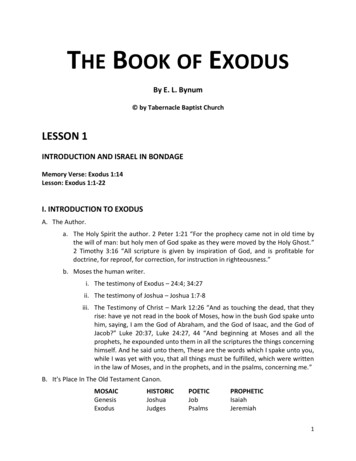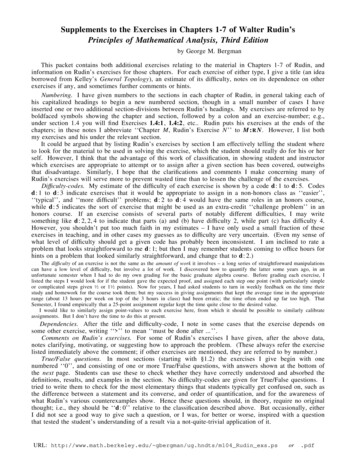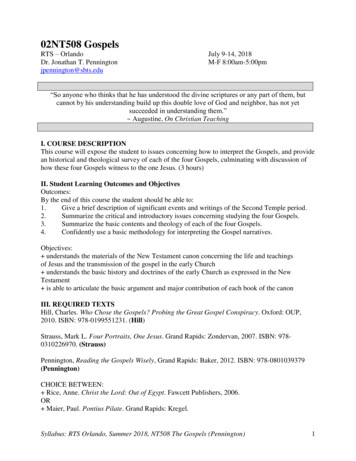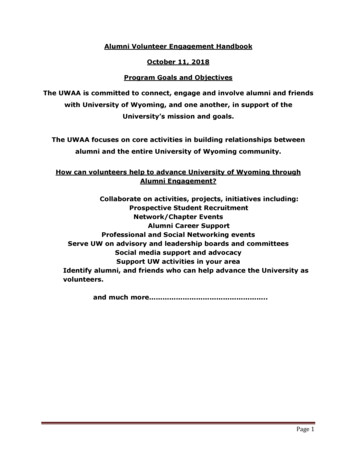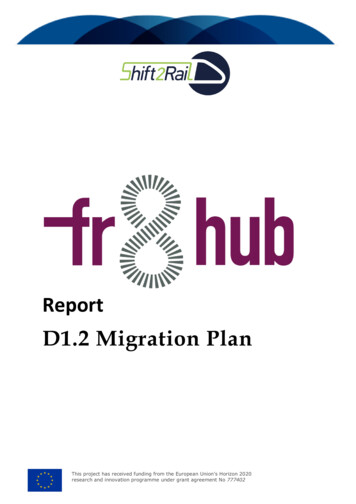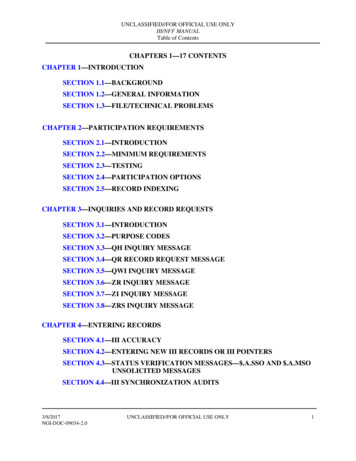
Transcription
UNCLASSIFIED//FOR OFFICIAL USE ONLYIII/NFF MANUALTable of ContentsCHAPTERS 1—17 CONTENTSCHAPTER 1—INTRODUCTIONSECTION 1.1—BACKGROUNDSECTION 1.2—GENERAL INFORMATIONSECTION 1.3—FILE/TECHNICAL PROBLEMSCHAPTER 2—PARTICIPATION REQUIREMENTSSECTION 2.1—INTRODUCTIONSECTION 2.2—MINIMUM REQUIREMENTSSECTION 2.3—TESTINGSECTION 2.4—PARTICIPATION OPTIONSSECTION 2.5—RECORD INDEXINGCHAPTER 3—INQUIRIES AND RECORD REQUESTSSECTION 3.1—INTRODUCTIONSECTION 3.2—PURPOSE CODESSECTION 3.3—QH INQUIRY MESSAGESECTION 3.4—QR RECORD REQUEST MESSAGESECTION 3.5—QWI INQUIRY MESSAGESECTION 3.6—ZR INQUIRY MESSAGESECTION 3.7—ZI INQUIRY MESSAGESECTION 3.8—ZRS INQUIRY MESSAGECHAPTER 4—ENTERING RECORDSSECTION 4.1—III ACCURACYSECTION 4.2—ENTERING NEW III RECORDS OR III POINTERSSECTION 4.3—STATUS VERIFICATION MESSAGES— .A.SSO AND .A.MSOUNSOLICITED MESSAGESSECTION 4.4—III SYNCHRONIZATION AUDITS3/8/2017NGI-DOC-09034-2.0UNCLASSIFIED//FOR OFFICIAL USE ONLY1
UNCLASSIFIED//FOR OFFICIAL USE ONLYIII/NFF MANUALTable of ContentsCHAPTER 5—MAINTAINING RECORDSSECTION 5.1—MODIFYING THE STATE ACTIVE III POINTER (MRSMODIFICATION MESSAGE)SECTION 5.2—ENTERING SUPPLEMENTAL IDENTIFIERS (EHN UPDATEMESSAGE)SECTION 5.3—CANCELING SUPPLEMENTAL IDENTIFIERS (XHNCANCELLATION MESSAGE)SECTION 5.4—DELETING STATE RECORDS INDEXED IN THE III (DRSDELETION MESSAGE)SECTION 5.5—REMOVING STATE RECORDS INDEXED IN THE III FORDECEASED INDIVIDUALS (DEC DECEASED MESSAGE AND .A.DEC UNSOLICITED MESSAGE)SECTION 5.6—CONSOLIDATING STATE RECORDS INDEXED IN THE III( .A.CON AND .A.NMS UNSOLICITED MESSAGES)SECTION 5.7—UPDATING STATE RECORDS WITH DISPOSITION DATA(DSP UPDATE MESSAGE)CHAPTER 6—APPLICANT FINGERPRINT PROCESSINGSECTION 6.1—PROCEDURES FOR PROCESSING APPLICANTFINGERPRINTSSECTION 6.2—APPLICANT FINGERPRINT SUBMISSIONS IDENTIFIED ATTHE STATE LEVELSECTION 6.3—ALTERNATIVES FOR PROCESSING APPLICANTFINGERPRINT SUBMISSIONSSECTION 6.4—USE OF THE .A.CFN MESSAGE WHEN APPLICANTFINGERPRINT SUBMISSIONS ARE NOT IDENTIFIEDSECTION 6.5—USE OF THE .A.CFR MESSAGE WHEN APPLICANTFINGERPRINT SUBMISSIONS ARE IDENTIFIEDSECTION 6.6—NONCRIMINAL JUSTICE RAP BACK SERVICE3/8/2017NGI-DOC-09034-2.0UNCLASSIFIED//FOR OFFICIAL USE ONLY2
UNCLASSIFIED//FOR OFFICIAL USE ONLYIII/NFF MANUALTable of ContentsCHAPTER 7—SPECIAL FLAGS AND RECORD CYCLESSECTION 7.1—IDENTIFICATION FOR FIREARMS SALES (IFFS)SECTION 7.2—CONVICTED SEXUAL OFFENDER REGISTRY NOTICESSECTION 7.3—WANTED NOTICESSECTION 7.4—FLASH NOTICESSECTION 7.5—III SEALING PROGRAMCHAPTER 8—NATIONAL FINGERPRINT FILE (NFF) PARTICIPATIONREQUIREMENTSSECTION 8.1—INTRODUCTIONSECTION 8.2—STATE NFF QUALIFICATION REQUIREMENTSCHAPTER 9—RECORD REQUEST PROCESSING FOR NFF STATESSECTION 9.1—INTRODUCTIONSECTION 9.2—RECORD PROCESSING BY NFF STATESCHAPTER 10—RESPONDING TO CRIMINAL TENPRINT CONTRIBUTORSSECTION 10.1—INTRODUCTIONSECTION 10.2—RESPONDING TO NON-NFF STATES AND LOCAL ANDFEDERAL CONTRIBUTORSSECTION 10.3—NFF STATE’S RESPONSE TO ITS STATE AND LOCALCONTRIBUTORSSECTION 10.4—RESPONDING TO AN NFF STATE AND ITS CONTRIBUTORSWHEN THE STATE DOES NOT IDENTIFY THE IFIED//FOR OFFICIAL USE ONLY3
UNCLASSIFIED//FOR OFFICIAL USE ONLYIII/NFF MANUALTable of ContentsCHAPTER 11—APPLICANT FINGERPRINT PROCESSINGSECTION 11.1—APPLICANT FINGERPRINT PROCESSINGSECTION 11.2—APPLICANT FINGERPRINT SUBMISSIONS IDENTIFIED ATTHE STATE LEVELSECTION 11.3—ALTERNATIVES FOR PROCESSING APPLICANTFINGERPRINT SUBMISSIONSSECTION 11.4—USE OF THE .A.CFN AND .A.CFR MESSAGESSECTION 11.5—FBI RETRIEVES IdHSCHAPTER 12—ESTABLISHING NFF RECORDSSECTION 12.1—INTRODUCTIONSECTION 12.2—INITIAL CRIMINAL TENPRINTS SUBMITTED BY AN NFFSTATE (FINGERPRINTS IDENTIFIED OR NOT IDENTIFIEDWITH A CRIMINAL RECORD)SECTION 12.3—CRIMINAL TENPRINTS WITHOUT SIDS SUBMITTED BYSTATES PARTICIPATING IN THE NFFSECTION 12.4—III RECORDS THAT WILL BECOME NFF RECORDSCHAPTER 13—CRIMINAL TENPRINTS IDENTIFIED BY AN NFF STATESECTION 13.1—INTRODUCTIONSECTION 13.2—NOTIFYING THE FBI WHEN A SUBSEQUENT CRIMINALSUBSEQUENT ARRESTS IDENTED TO AN NFF RECORDTENPRINT IS IDENTIFIEDSECTION 13.3—NFF STATE PARTICIPATION IN IDENT/NGI BIOMETRICINTEROPERABILITYSECTION 13.4—UPDATING THE III WITH SUPPLEMENTAL FOR OFFICIAL USE ONLY4
UNCLASSIFIED//FOR OFFICIAL USE ONLYIII/NFF MANUALTable of ContentsCHAPTER 14—EXCEPTION PROCESSINGSECTION 14.1—INTRODUCTIONSECTION 14.2—PROCESSING TENPRINTS SUBMITTED BY NFF STATESSECTION 14.3—PROCESSING NFF STATE RECORD EXPUNGEMENTSSECTION 14.4—PROCESSING INCOMING DECEASED (DEC) MESSAGESSUBMITTED BY NFF STATESSECTION 14.5—PROCESSING FBI RECORD CONSOLIDATIONS BY NFFSTATESSECTION 14.6—MISCELLANEOUS PROCESSING PROCEDURESCHAPTER 15—III CRIMINAL HISTORY RECORD SEALING PROGRAMSECTION 15.1—INTRODUCTIONSECTION 15.2—NFF SEALING PROGRAM DESIGNCHAPTER 16—WANTED PERSON AND SEXUAL OFFENDER INFORMATION ANDFLASH NOTICESSECTION 16.1—INTRODUCTIONSECTION 16.2—PROCESSING WANTED PERSON INFORMATIONSECTION 16.3—SEX OFFENDER NOTIFICATION IN CRIMINAL HISTORYRECORDSSECTION 16.4—PROCESSING FLASH NOTICESCHAPTER 17—FILE AUDITSSECTION 17.1—INTRODUCTIONSECTION 17.2—FREQUENCY OF SYNCHRONIZATION AUDITS3/8/2017NGI-DOC-09034-2.0UNCLASSIFIED//FOR OFFICIAL USE ONLY5
UNCLASSIFIED//FOR OFFICIAL USE ONLYIII/NFF MANUALTable of ContentsAPPENDIX 1 THROUGH W CONTENTSAPPENDIX 1LIST OF APPENDICES A THROUGH WAPPENDIX AFIELD EDIT SPECIFICATIONSAPPENDIX BINTERSTATE IDENTIFICATION INDEX BASIC TECHNICALINFORMATIONAPPENDIX CREJECT MESSAGESAPPENDIX DINTERSTATE IDENTIFICATION INDEX SINGLESOURCE/MULTI-SOURCE TEST RECORDSAPPENDIX ENlets CONTROL FIELD SPECIFICATIONAPPENDIX FCHECK-DIGIT ROUTINES—FBI UNIVERSAL CONTROLNUMBERSAPPENDIX GINTERSTATE IDENTIFICATION INDEX ADMINISTRATIVEMESSAGESAPPENDIX HFD-1114 FBI EXPUNGEMENT FORM AND FD-1115 RECORDSMODIFICATION FORMAPPENDIX IDATE OF ARREST CUT-OFF DATESAPPENDIX JNEXT GENERATION IDENTIFICATION EQUIVALENTMESSAGE FOR .A.NPR, .A.PIR, .A.CFN, AND .A.CFRAPPENDIX KNEXT GENERATION IDENTIFICATION EQUIVALENTMESSAGE FOR .A.NMS WHEN THE TENPRINT CONTAINS ADIFFERENT SID NUMBERAPPENDIX LNEXT GENERATION IDENTIFICATION EQUIVALENTMESSAGE FOR .A.RNP AND .A.RPR WHEN THE NATIONALFINGERPRINT FILE TENPRINT CONTAINS A SID NUMBERFOR A DIFFERENT FBI UCN*APPENDIX MNEXT GENERATION IDENTIFICATION MESSAGE WHEN THENATIONAL FINGERPRINT FILE TENPRINT DOES NOTCONTAIN A SID NUMBER*APPENDIX NFINGERPRINT IMAGE SUBMISSION TYPE OF TRANSACTION*APPENDIX ONEXT GENERATION IDENTIFICATION REJECT MESSAGEWHEN THE NATIONAL FINGERPRINT FILE TENPRINT ISNOT IDENTICAL TO THE RECORD FOR WHICH THETENPRINT IS BEING OR OFFICIAL USE ONLY6
UNCLASSIFIED//FOR OFFICIAL USE ONLYIII/NFF MANUALTable of ContentsAPPENDIX PNEXT GENERATION IDENTIFICATION RESPONSE MESSAGEWHEN THE NATIONAL FINGERPRINT FILE TENPRINT ISSUBMITTED AS A FINGERPRINT IMAGE SUBMISSION TYPEOF TRANSACTION*APPENDIX QNEXT GENERATION IDENTIFICATION TERMS USED IN THENATIONAL FINGERPRINT FILE PROGRAM*APPENDIX RCRIMINAL HISTORY RECORD SCREENING FORAUTHORIZED NONCRIMINAL JUSTICE PURPOSESAPPENDIX SINTERSTATE IDENTIFICATION INDEX SYNCHRONIZATIONGUIDELINESAPPENDIX TINTERSTATE IDENTIFICATION INDEX CORRELATIONGUIDELINESAPPENDIX UACRONYMS AND CODESAPPENDIX VGLOSSARYAPPENDIX WQUICK REFERENCE*Message only applies to NFF participating states3/8/2017NGI-DOC-09034-2.0UNCLASSIFIED//FOR OFFICIAL USE ONLY7
UNCLASSIFIED//FOR OFFICIAL USE ONLYIII/NFF MANUALChapter 1—IntroductionCHAPTER 1—INTRODUCTION . 2SECTION 1.1–BACKGROUND . 21.1.1 INTERSTATE IDENTIFICATION INDEX (III) PROGRAM . 21.1.2 NATIONAL FINGERPRINT FILE (NFF) PROGRAM . 31.1.3 NATIONAL CRIME PREVENTION AND PRIVACY COMPACT ACT(COMPACT). 31.1.4 PROHIBITED USE . 41.1.5 CJIS APB COMPLIANCE EVALUATION SUBCOMMITTEE (CES)SANCTIONS PROCESS . 4SECTION 1.2—GENERAL INFORMATION . 51.2.1 PURPOSES OF THIS MANUAL . 51.2.2 COMPONENTS OF THIS MANUAL . 5SECTION 1.3—FILE/TECHNICAL PROBLEMS . 61.3.1 INTRODUCTION . 61.3.2 RESPONSE WHEN THE III IS EXPERIENCING A FILE PROBLEM . 61.3.3 RESPONSE WHEN THE NCIC ENCOUNTERS A TECHNICAL PROBLEMWITH THE TRANSMISSION OF A RESPONSE FROM THE III. 61.3.4 RESPONSE WHEN THE III IS IN SERVICE BUT UNABLE TO ACCEPTMESSAGES. 71.3.5 RESPONSE WHEN THE III ENCOUNTERS A TECHNICAL PROBLEM . 73/8/2017NGI-DOC-09034-2.0UNCLASSIFIED//FOR OFFICIAL USE ONLY1
UNCLASSIFIED//FOR OFFICIAL USE ONLYIII/NFF MANUALChapter 1—IntroductionCHAPTER 1—INTRODUCTIONSECTION 1.1–BACKGROUND1.1.1INTERSTATE IDENTIFICATION INDEX (III) PROGRAMThe III Program provides for the decentralized interstate exchange of Identity History Summary(IdHS) records and functions as part of the FBI Criminal Justice Information Services (CJIS)Division’s Next Generation Identification (NGI) System. The National Crime InformationCenter (NCIC) Advisory Policy Board (APB) (currently the CJIS APB), which has oversight ofthe III Program, approved the Program in April 1978. Currently, all 50 states and the District ofColumbia participate in the III Program.Duplicate criminal history repositories and shared record dissemination responsibilities betweenIII and state systems are the foundation upon which the III is built. Accordingly, the FBI sharesmanagement responsibility for the III with CJIS Systems Agencies (CSAs) that service NCICand III users in their states. An example of a CSA is a state police organization that connectsmany local departments to the CJIS systems through a state computer system. CSAs sign writtenagreements with the FBI to confirm they will abide by the rules, policies, and proceduresgoverning III operations. These agencies, in turn, prepare and execute similar agreements withtheir users. All participating agencies are thereby bound to a set of guidelines that regulate accessto the III, outline the authorized uses of the system and the data derived from it, and explain therequired minimum security measures.The III provides a means of conducting national record searches for criminal justice and otherpurposes as specified by existing local, state, and/or federal laws. Any authorized criminal ornoncriminal justice agency may access the III. The III processes name check inquiry transactionsto determine if a matching record, indexed by a unique FBI Universal Control Number (UCN), ison file. If a match is found, an agency may request the subject’s record by transmitting anadditional inquiry using a FBI UCN or state identification (SID Number) assigned to thesubject’s record. Generally, records are provided to requesters within seconds over the FBItelecommunications network to the III.Each IdHS record is supported by a fingerprint submission and is assigned a unique FBI UCN. Inthe 54 sole-source participating states/territories, the arresting agency submits fingerprint imagesto the State Identification Bureau (SIB) for processing and assignment of a SID Number. (Asole-source agency submits all information through a single conduit, such as a state repository.The term sole-source agency should not be confused with a single-source record, which indicatesthat a particular record has one source, or state, contributing to the subject’s record. Moreinformation about sole-source agencies and single-source records is available in the Glossaryportion of this document.) The SIB updates its state file and sends the arrest information to theFBI. If no prior FBI record is on file, the FBI establishes a new record in the III, assigns an FBIUCN, and creates an index of the subject’s descriptors. A message is sent back to the statecontaining this FBI UCN. The state repository must then enter the FBI UCN into the state systemat the central repository to ensure an accurate and complete III response for future ED//FOR OFFICIAL USE ONLY2
UNCLASSIFIED//FOR OFFICIAL USE ONLYIII/NFF MANUALChapter 1—IntroductionWhen the FBI receives an online request for a record supported by a III participating state, the IIIautomatically sends a message through the FBI telecommunications network to the participatingstate’s computer system. The state responds directly to the requesting agency over theInternational Justice and Public Safety Network (Nlets). The FBI’s CJIS Division responds torequests for records for the U.S. territories and for criminal history records that III states areunable to support. For fingerprint submissions, the FBI’s CJIS Division provides records fornon-National Fingerprint File (NFF) states whose records are designated by a state pointer thatdo not respond to applicable purpose codes, and for states whose records are not designated by astate pointer (pseudo-pointer) records. Records maintained by NFF Program participants, andrecords maintained by states whose records are designated by a state pointer and respond to thespecific purpose codes, are provided by the respective states.Any problems or questions regarding the use of the III can be directed to the III staff at the FBICJIS Division by e-mail to fbi-iii@leo.gov .1.1.2NATIONAL FINGERPRINT FILE (NFF) PROGRAMWhen the III concept was adopted to decentralize criminal history record keeping in 1978, theNFF was the concept’s ultimate goal. When fully implemented, the NFF will be a decentralizedsystem that will replace the FBI’s record keeping responsibility for state offenders by makingstate repositories primarily responsible for record dissemination and maintenance. An NFF statesubmits a single fingerprint image for each offender to the FBI to identify the offender at thenational level. The state uses arrest fingerprint images and related disposition and expungementdocuments for subsequent arrests to update its own records; the state will forward only thosefingerprint images that it is unable to identify to the FBI. Accordingly, state repositories willbecome the only sources of state criminal history records for these arrests, for both criminal andnoncriminal justice purposes.1.1.3NATIONAL CRIME PREVENTION AND PRIVACY COMPACT ACT(COMPACT)Most states participating in the III have varying statutes or policies that restrict the disseminationof records for noncriminal justice purposes. Because of this, the states and the federalgovernment needed an agreement to permit interstate dissemination of national criminal historyrecords based on federal statute, federal executive order, or state statute approved by the U.S.Attorney General. For this reason, President Clinton signed the National Crime Prevention andPrivacy Compact Act (Compact) into law in October 1998. The Compact facilitates uniformity inthe dissemination of records among states for noncriminal justice purposes and requires that asignatory state provide its records upon request for all authorized noncriminal justice purposes. Astate must ratify the Compact prior to becoming an NFF participant. As more states join theCompact and the NFF Program grows, a greater uniformity and decentralization in the sharing ofnoncriminal justice information will occur.3/8/2017NGI-DOC-09034-2.0UNCLASSIFIED//FOR OFFICIAL USE ONLY3
UNCLASSIFIED//FOR OFFICIAL USE ONLYIII/NFF MANUALChapter 1—Introduction1.1.4PROHIBITED USEAuthorized agencies must not use the III for remotely accessing a record to be reviewed and/orchallenged by the subject of the record. Record requests for this purpose must be submitted inwriting to either the FBI’s CJIS Division or the state of record accompanied by fingerprints.Authorized personnel may not conduct III record inquiries without a specific purpose. It isprohibited to conduct III record inquiries on family, friends, or one’s self. Such misuse is subjectto sanctions against the state, as well as civil and/or criminal penalties to the person misusing thesystem.1.1.5CJIS APB COMPLIANCE EVALUATION SUBCOMMITTEE (CES)SANCTIONS PROCESSThe Compact Council at Article VI established the Compact Council (Council). The CompactCouncil Sanctions Committee is responsible for ensuring that use of the Interstate IdentificationIndex System for noncriminal justice purposes complies with the Compact and with rules,standards, and procedures established by the Compact Council. As such, the SanctionsCommittee reviews the results of audits conducted by the FBI of participants in the FBI’s CJISDivision programs. The Sanctions Committee reviews the audit results and the participant’sresponse to determine a course of action necessary to bring the participant into compliance andmake recommendations to the Compact Council or the FBI. Additional information on theCompact Council Sanctions process is available on the Compact Council’s Web site at y-process#Compliance-EvaluationSubcommittee .3/8/2017NGI-DOC-09034-2.0UNCLASSIFIED//FOR OFFICIAL USE ONLY4
UNCLASSIFIED//FOR OFFICIAL USE ONLYIII/NFF MANUALChapter 1—IntroductionSECTION 1.2—GENERAL INFORMATION1.2.1PURPOSES OF THIS MANUALThis manual is intended to:A. Describe the III and the NFF Programs.B. Explain how to understand and use III and NFF messages.C. Provide technical and operational details to state/territorial agencies participating orplanning to participate in the III and the NFF.D. Describe the procedures for entering, maintaining, and updating III and NFF records.E. Explain the FBI’s special flags and record cycles and why they are important to the IIIand the NFF.F. Provide state and federal agencies with the FBI’s procedures for processing responses tocriminal and noncriminal fingerprint submissions that are identified with III and NFFrecords.G. Provide those states having noncriminal justice screening requirements with the optionsfor responding to noncriminal justice tenprint submissions.H. Provide additional clarifying information and details.1.2.2COMPONENTS OF THIS MANUALThis manual is divided into two components: the III section and the NFF section. Eachcomponent provides general information and operational details for the respective programs. Inan effort to maintain III and NFF information in a single publication versus separate technicalmemoranda, reports, etc., revisions to this manual will be published periodically.In addition to the III and NFF components, this manual contains a glossary of terms, an index ofacronyms and codes, and various appendices to help the user understand the III and NFFPrograms. A Quick Reference Guide is also available to assist users in locating informationabout the inquiry, test, maintenance, unsolicited, and administrative messages used by the III andNFF Programs. Many of the codes and terms used in the III and NFF Programs can also be foundin the NCIC Operating Manual and the NCIC Code Manual. In addition to these resources, IIIusers may also obtain assistance by contacting the III staff at fbi-iii@leo.gov .3/8/2017NGI-DOC-09034-2.0UNCLASSIFIED//FOR OFFICIAL USE ONLY5
UNCLASSIFIED//FOR OFFICIAL USE ONLYIII/NFF MANUALChapter 1—IntroductionSECTION 1.3—FILE/TECHNICAL PROBLEMS1.3.1INTRODUCTIONOccasionally, technical or other types of problems may prevent the III from transmitting animmediate response to an inquiry or a record request (as detailed in Chapter 3) or a maintenancemessage (as detailed in Chapter 5). Whenever file or technical problems occur in the transmittalof a response, the III will notify the user with a message containing a response header beginningwith GL01.1.3.2RESPONSE WHEN THE III IS EXPERIENCING A FILE PROBLEMWhen the III experiences problems responding to an inquiry or record request, it willimmediately transmit the example response provided below. The response will always beginwith the response header characters GL01.GL01HEADERXXXX01234VAVSP0000THE FBI IS UNABLE TO PROVIDE A RESPONSE FOR FBI/9030300. FBI PERSONNELWILL RESEARCH THE PROBLEM AND YOU WILL BE ADVISED.ENDAs appropriate in this type of response, the III will replace the FBI UCN with a SID Number. Forsearch inquiry (QH) responses, the III will replace the FBI UCN with a NAM/(name) and theother search fields from the inquiry.1.3.3RESPONSE WHEN THE NCIC ENCOUNTERS A TECHNICAL PROBLEMWITH THE TRANSMISSION OF A RESPONSE FROM THE IIIWhen a problem is encountered in the transmission of a response from the III, it will transmitimmediately the example response provided below via the FBI telecommunications network. Theresponse will always begin with the response header characters GL01.GL01HEADERXXXX01234VAVSP0000THE FBI EXPERIENCED A TECHNICAL PROBLEM WHILE PROCESSING YOUR REQUESTFOR FBI/9040400. IF YOU DID NOT RECEIVE YOUR RESPONSE, PLEASE MAKEANOTHER REQUEST.ENDAs appropriate in this type of response, the III will replace the FBI UCN with a SID/(SIDNumber). For QH inquiry responses, the III will replace the FBI UCN with a NAM/(name) andthe other search fields from the inquiry.3/8/2017NGI-DOC-09034-2.0UNCLASSIFIED//FOR OFFICIAL USE ONLY6
UNCLASSIFIED//FOR OFFICIAL USE ONLYIII/NFF MANUALChapter 1—Introduction1.3.4RESPONSE WHEN THE III IS IN SERVICE BUT UNABLE TO ACCEPTMESSAGESWhen an inquiry or record request message has been in the system’s queue for 3 hours and theIII is unable to process the message, it will transmit the example response provided below. Upontransmission of this response, the III will purge the inquiry or record request message. Theresponse will always begin with the response header characters GL01. Maintenance messagesremain in the queue until the III can accept them.GL01HEADERXXXX01234VAVSP0000THE FBI EXPERIENCED A TECHNICAL PROBLEM WHILE PROCESSING YOUR REQUESTFOR FBI/9015174. IF YOU DID NOT RECEIVE YOUR RESPONSE, PLEASE MAKEANOTHER REQUEST.ENDAs appropriate in this type of response, the III will replace the FBI UCN with a SID Number. ForQH inquiry responses, the III will replace the FBI UCN with a name (NAM) and data from theother search fields from the inquiry.1.3.5RESPONSE WHEN THE III ENCOUNTERS A TECHNICAL PROBLEMOccasionally, the III cannot provide a response to the incoming message or cannot provide animmediate GL01 response due to technical problems. In the early hours of each workday, the IIIsoftware reviews the previous day’s messages to detect any message for which a response wasnot generated. When no response was generated for an inquiry, a record request, or amaintenance message, the III will transmit the example response provided below. The GL01response provides the time (in Eastern Time) and the date when the message was received.GL01HEADERXXXX01234VAVSP0000DUE TO A TECHNICAL PROBLEM, THE FBI WAS UNABLE TO PROVIDE A RESPONSEFOR FBI/9015174. YOUR REQUEST WAS RECEIVED AT 2115 EST ON 2014/10/07.PLEASE MAKE ANOTHER REQUEST IF YOU HAVE NOT ALREADY DONE SO.ENDAs appropriate in this type of response, the III will replace the FBI UCN with a SID Number. ForQH inquiry responses, the III will replace the FBI UCN with a NAM and data from the othersearch fields from the inquiry. For maintenance messages, the III will replace the FBI UCN withthe record identifiers (date of birth [DOB] or SID Number and FBI UCN) and the Message FieldCode (MFC) data included in the incoming maintenance message.3/8/2017NGI-DOC-09034-2.0UNCLASSIFIED//FOR OFFICIAL USE ONLY7
UNCLASSIFIED//FOR OFFICIAL USE ONLYIII/NFF MANUALChapter 2—Participation RequirementsCHAPTER 2—PARTICIPATION REQUIREMENTS . 3SECTION 2.1—INTRODUCTION . 32.1.1GENERAL INFORMATION . 32.1.2TESTING CAPABILITIES . 32.1.3OTHER CAPABILITIES . 42.1.4PREREQUISITES FOR III PARTICIPATION . 4SECTION 2.2—MINIMUM REQUIREMENTS . 62.2.1TENPRINT IDENTIFICATION MATTERS. 62.2.2RECORD CONTENT AND III MAINTENANCE. 62.2.3RECORD RESPONSES . 72.2.4ACCOUNTABILITY . 7SECTION 2.3—TESTING . 82.3.1INTRODUCTION . 82.3.2TI MESSAGE TO GENERATE TRANSMISSION OF .A. MESSAGES . 82.3.3TYPES OF UNSOLICITED MESSAGES THAT CAN BE TESTED USING THETI MESSAGE KEY . 92.3.4 .A.CHR UNSOLICITED MESSAGE RESPONSE TO A TI MESSAGE. 11SECTION 2.4—PARTICIPATION OPTIONS. 132.4.1INTRODUCTION . 132.4.2PARTICIPATION START DATE . 132.4.3POINTER DATA. 132.4.4DATE OF ARREST CUTOFF . 142.4.5ADMINISTRATIVE ACCESS ORI . 152.4.6ZERO-FILLED SID NUMBERS . 152.4.7RECORD RESPONSES . 152.4.8MANDATORY PURPOSES FOR WHICH STATES MUST PROVIDE THEIRRECORDS. 15SECTION 2.5—RECORD INDEXING . 162.5.1INTRODUCTION . 162.5.2CCH CORRELATION . 162.5.3RECORD MATCHING . 162.5.4RECORD MATCHING DISCREPANCIES . 173/8/2017NGI-DOC-09034-2.0UNCLASSIFIED//FOR OFFICIAL USE ONLY1
UNCLASSIFIED//FOR OFFICIAL USE ONLYIII/NFF MANUALChapter 2—Participation Requirements2.5.5REPORTING POSSIBLE CONSOLIDATIONS, SEALED RECORDS, OREXPUNGED RECORDS . 182.5.6ESTABLISHING SID NUMBERS AS III POINTERS . 19SECTION 2.6—STATE RESPONSE PROCEDURES TO III RECORD REQUESTS . 232.6.1INTRODUCTION . 232.6.2EXAMPLE .A.CHR UNSOLICITED MESSAGE—CRIMINAL HISTORYREQUEST NOTIFICATION . 232.6.3RECORD REQUEST (QR) BY IN-STATE AGENCY ACCESSING THE III . 242.6.4CENTRAL REPOSITORY RESPONSE FROM STATE—INTRODUCTION . 243/8/2017NGI-DOC-09034-2.0UNCLASSIFIED//FOR OFFICIAL USE ONLY2
UNCLASSIFIED//FOR OFFICIAL USE ONLYIII/NFF MANUALChapter 2—Participation RequirementsCHAPTER 2—PARTICIPATION REQUIREMENTSSECTION 2.1—INTRODUCTION2.1.1GENERAL INFORMATIONStates and territories desiring to participate in the Interstate Identification Index (III) Programmust meet specified standards prior to participation. These standards are covered in Section 2.2of this chapter and include requirements for tenprint identification, record content and IIImaintenance, record response, and accountability. Among the standards is the requirement that astate must be able to provide its state records automatically via the National Law EnforcementTelecommunications System (Nlets) upon receipt of a III criminal history record requestmessage ( .A.CHR). Section 2.6.2 of this chapter describes the .A.CHR message and theagency’s requirements for properly formatting an Nlets message to identify the record and therequester.2.1.2TESTING CAPABILITIESThe nonoperational environment (NOE) is available to III/National Fingerprint File (NFF)participating and nonparticipating states for III/NFF testing purposes. The NOE supports the TI testing protocol, which allows states to test the receipt of .A. unsolicited messages. Additionalinformation about the TI testing message is available in Section 2.3, and information aboutunsolicited messages is available in the Quick Reference portion of this manual. States mustaccept and process the various unsolici
(IdHS) records and functions as part of the FBI Criminal Justice Information Services (CJIS) Division's Next Generation Identification (NGI) System. The National Crime Information Center (NCIC) Advisory Policy Board (APB) (currently the CJIS APB), which has oversight of the III Program, approved the Program in April 1978.

